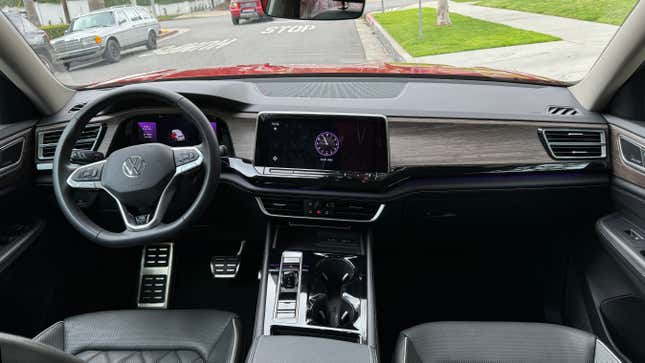If there’s one thing that riles up auto journalists into a (usually) light-hearted argument, it’s talking about climate control systems. I’ve been in many heated debates about whether or not automatic climate control is good, what the optimal temperature and fan speed is, and where the air vents should be placed. Don’t even get me started on where the climate controls should be and what kind of controls they are — personally, I don’t mind touch controls, they just need to be good.
What I personally have a strong feeling about is where I want the air vents to direct my air flow. As a driver, I usually like it when both the central vent and the one to the left of the gauges and steering wheel are pointed at my hands — they can get kinda sweaty, especially when driving quickly — and at my face. Sometimes vents don’t have enough air flow or spread to nicely hit both hands and face, or they can’t be angled enough to properly cool where I want. But the Volkswagen Atlas’ recent 2024 model year refresh added clever air vents that not only solve that problem but provide one of the best climate control vent experiences I’ve had in recent memory.

The 2024 Atlas’ new vent setup isn’t groundbreaking or special in terms of engineering or design, but it does provide a huge quality of life boost. Instead of having a single vent on each end of the dashboard like before, the Atlas’ trapezoidal surrounds each house two separately controllable air flow vents stacked on top of each other that are being fed by the same duct. This means that I can have the top half of the vent pointed one way, and the bottom half pointed another way. It’s genius!
You can’t separately adjust the flow between those two vents — meaning if you have them set to one intensity, you can’t have the top half blowing stronger than the bottom half — but you can close off one or both of the vents if you so desire. This setup lets me have air hitting my face and my hands and my arm. It’s fantastic.

The pre-facelift Atlas had a vertically oriented vent on each side of the central touchscreen, but the 2024 model has a pair of slim vents positioned in the dash below the screen, and they don’t get the same split design as the vents on the end, which is a shame. And you’re still stuck with VW’s now-outdated infotainment setup, meaning the touch-sensitive temperature sliders just below the screen aren’t illuminated, which is really infuriating. The rest of the climate functions are controlled through the screen itself, which I think is totally fine. I’m the kind of person who typically just sets it to automatic and 72 degrees anyway.
Curiously, Volkswagen made no mention of the redesigned air vents in its press release and other materials when the Atlas facelift was launched last spring, instead focusing on the SUV’s bigger screens, nicely redesigned dashboard and center console, and other “more important” features. And it doesn’t seem like these vents will stick around long, as VW’s other newly designed models like the Euro-only Passat, the ID 7 and ID Buzz have more sleek, slim air vents that can only be pointed a single direction. That’s a shame.


